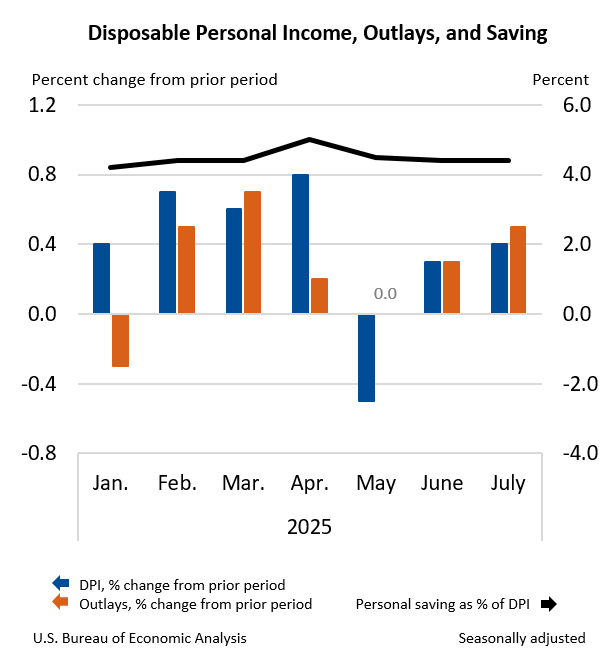Bureau of Economic Analysis
Personal Income and Outlays, July 2025
Personal income increased $112.3 billion (0.4 percent at a monthly rate) in July, according to estimates released today by the U.S. Bureau of Economic Analysis. Disposable personal income (DPI)—personal income less personal current taxes—increased $93.9 billion (0.4 percent) and personal consumption expenditures (PCE) increased $108.9 billion (0.5 percent). Personal outlays—the sum of PCE, personal interest payments, and personal current transfer payments—increased $110.9 billion in July. Personal saving was $985.6 billion in July and the personal saving rate—personal saving as a percentage of disposable personal income—was 4.4 percent.
Principal Federal Economic Indicators
Noteworthy
- 2025 News Release Schedule
- Innovation at BEA
- 2025 Annual Updates
- Distribution of Personal Income Nowcast
- New! Services Trade Data for More Countries
- Data Tool: Trade in Value Added
- Updated: RIMS II Regional Multipliers
- Arts and Culture
- Space Economy
- FDI Now in State BEARFACTS
- Quick Guide: Price Indexes
The Latest
Nondurable Goods Manufacturing Led the Downturn in First Quarter Gross Domestic Product by Industry
A deceleration in nondurable goods manufacturing and downturns in both professional, scientific, and technical services and wholesale trade were the leading contributors to the downturn in U.S. economic growth in the first quarter of 2015. Overall, 15 of 22 industry groups contributed to the downturn in the first quarter.
Gross Domestic Product by Industry, 1st quarter, 2015
A deceleration in nondurable goods manufacturing and downturns in both professional, scientific, and technical services and wholesale trade were the leading contributors to the downturn in U.S. economic growth in the first quarter of 2015, according to statistics on the breakout of GDP by industry released today by the Bureau of Economic Analysis (BEA). Overall, 15 of 22 industry groups contributed to the downturn in the first quarter.
Why Does BEA Revise GDP Estimates?
Each summer, the Bureau of Economic Analysis updates its Gross Domestic Product estimates to incorporate sources of data previously unavailable and make improvements in methodology –– all with the goal of providing the most accurate measure of the U.S. economy’s performance.
Coming Soon: Webinar for BE–10 Survey Respondents—What Private Funds Need to Know
Take part in a webinar, co-hosted by the U.S. Bureau of Economic Analysis and the Association for Corporate Growth, on Thursday, July 16, at 2 p.m., where you’ll receive an overview of the BE–10 Benchmark Survey of U.S. Direct Investment Abroad and learn more about how it applies to private funds.
BEA's API Expands Access to All Regional Data
Developers, your requests have been heard. All regional data from the Bureau of Economic Analysis are now accessible through our application programming interface, or API. This includes industry detail for certain estimates, back-year estimates under the SIC industry structure and every statistic currently available in our interactive data tables.
May 2015 Trade Gap is $41.9 Billion
The U.S. monthly international trade deficit increased in May 2015 according to the U.S. Bureau of Economic Analysis and the U.S. Census Bureau. The deficit increased from $40.7 billion in April (revised) to $41.9 billion in May, as exports decreased more than imports. The previously published April deficit was $40.9 billion. The goods deficit increased $1.2 billion from April to $61.5 billion in May. The services surplus increased less than…
U.S. International Trade in Goods and Services, May 2015
U.S. Census Bureau U.S. Bureau of Economic Analysis NEWS U.S. Department of Commerce * Washington, DC 20230 U.S. INTERNATIONAL TRADE IN GOODS AND SERVICES MAY 2015 The U.S. Census Bureau and the U.S. Bureau of Economic Analysis, through the Department of Commerce, announced today…
Real Personal Income for States, 2013
Real personal income across all regions rose by an average of 0.8 percent in 2013. This growth rate reflects the year-over-year change in nominal personal income across all regions adjusted by the change in the national personal consumption expenditures (PCE) price index. On a nominal basis, personal income across all regions grew an average of 2.0 percent in 2013. In 2013, the U.S. PCE price index grew 1.2 percent.
Real Personal Income for Metropolitan Areas, 2013
Real personal income across all regions rose by an average of 0.8 percent in 2013. This growth rate reflects the year-over-year change in nominal personal income across all regions adjusted by the change in the national personal consumption expenditures (PCE) price index. On a nominal basis, personal income across all regions grew an average of 2.0 percent in 2013. In 2013, the U.S. PCE price index grew 1.2 percent.
Real Personal Income for States and Metropolitan Areas, 2013
Real personal income across all regions rose by an average of 0.8 percent in 2013. This growth rate reflects the year-over-year change in nominal personal income across all regions adjusted by the change in the national personal consumption expenditures (PCE) price index. On a nominal basis, personal income across all regions grew an average of 2.0 percent in 2013. In 2013, the U.S. PCE price index grew 1.2 percent.




